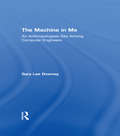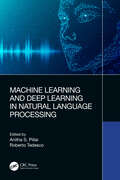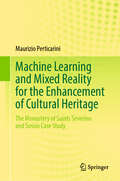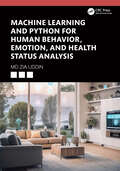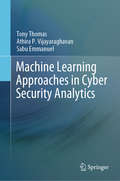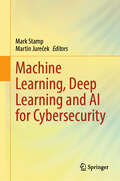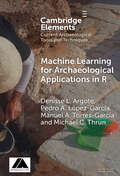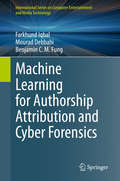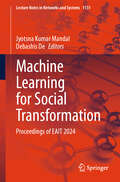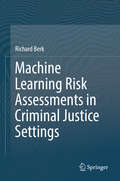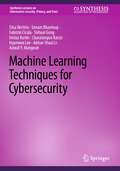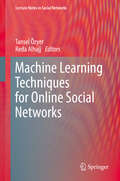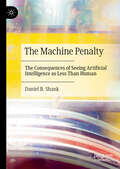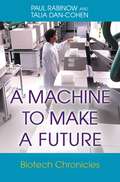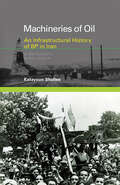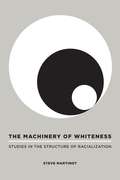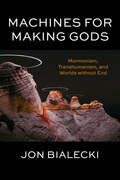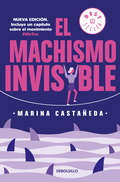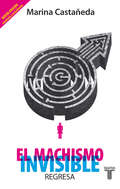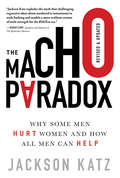- Table View
- List View
The Machine in Me: An Anthropologist Sits Among Computer Engineers
by Gary Lee DowneyFirst Published in 1998. Routledge is an imprint of Taylor & Francis, an informa company.
Machine Learning and Deep Learning in Natural Language Processing
by Anitha S. Pillai Roberto TedescoNatural Language Processing (NLP) is a sub-field of Artificial Intelligence, linguistics, and computer science and is concerned with the generation, recognition, and understanding of human languages, both written and spoken. NLP systems examine the grammatical structure of sentences as well as the specific meanings of words, and then they utilize algorithms to extract meaning and produce results. Machine Learning and Deep Learning in Natural Language Processing aims at providing a review of current Neural Network techniques in the NLP field, in particular about Conversational Agents (chatbots), Text-to-Speech, management of non-literal content – like emotions, but also satirical expressions – and applications in the healthcare field. NLP has the potential to be a disruptive technology in various healthcare fields, but so far little attention has been devoted to that goal. This book aims at providing some examples of NLP techniques that can, for example, restore speech, detect Parkinson’s disease, or help psychotherapists. This book is intended for a wide audience. Beginners will find useful chapters providing a general introduction to NLP techniques, while experienced professionals will appreciate the chapters about advanced management of emotion, empathy, and non-literal content.
Machine Learning and Mixed Reality for the Enhancement of Cultural Heritage: The Monastery of Saints Severino and Sossio Case Study
by Maurizio PerticariniThis book addresses the role of modern surveying and representation technologies in preserving and disseminating cultural heritage. A workflow is illustrated, describing the Former Monastery of Ss Severino and Sossio case study, currently the headquarters of the State Archives of Naples, Italy. After offering a historical overview, the work examines the spaces and structure of the building. A methodology for three-dimensional restitution is presented, using low-cost image-based and professional range-based surveying, concluding with recent AI technologies such as NeRF. The research continues with the virtual and augmented restitution of parts of the building that have been modified, lost over the centuries, or are no longer accessible. The Atrio dei Marmi, the Atrio del Platano, and the Sala del Capitolo and Sala del Refettorio are some of the places where the research has focused, creating a BIM model, using AR for precise interventions, and developing an immersive applied game to understand the third level of the monastery, rich in works of art and today also serving as a museum. In the final chapters, a particular focus is placed on the future of representation: new techniques, ongoing developments in AI supporting surveying, and the new possibilities offered by virtual spaces.
Machine Learning and Python for Human Behavior, Emotion, and Health Status Analysis
by Md Zia UddinThis book is a practical guide for individuals interested in exploring and implementing smart home applications using Python. Comprising six chapters enriched with hands-on codes, it seamlessly navigates from foundational concepts to cutting-edge technologies, balancing theoretical insights and practical coding experiences. In short, it is a gateway to the dynamic intersection of Python programming, smart home technology, and advanced machine learning applications, making it an invaluable resource for those eager to explore this rapidly growing field.Key Features: Throughout the book, practicality takes precedence, with hands-on coding examples accompanying each concept to facilitate an interactive learning journey Striking a harmonious balance between theoretical foundations and practical coding, the book caters to a diverse audience, including smart home enthusiasts and researchers The content prioritizes real-world applications, ensuring readers can immediately apply the knowledge gained to enhance smart home functionalities Covering Python basics, feature extraction, deep learning, and XAI, the book provides a comprehensive guide, offering an overall understanding of smart home applications
Machine Learning Approaches in Cyber Security Analytics
by Tony Thomas Athira P. Vijayaraghavan Sabu EmmanuelThis book introduces various machine learning methods for cyber security analytics. With an overwhelming amount of data being generated and transferred over various networks, monitoring everything that is exchanged and identifying potential cyber threats and attacks poses a serious challenge for cyber experts. Further, as cyber attacks become more frequent and sophisticated, there is a requirement for machines to predict, detect, and identify them more rapidly. Machine learning offers various tools and techniques to automate and quickly predict, detect, and identify cyber attacks.
Machine Learning, Deep Learning and AI for Cybersecurity
by Mark Stamp Martin JurečekThis book addresses a variety of problems that arise at the interface between AI techniques and challenging problems in cybersecurity. The book covers many of the issues that arise when applying AI and deep learning algorithms to inherently difficult problems in the security domain, such as malware detection and analysis, intrusion detection, spam detection, and various other subfields of cybersecurity. The book places particular attention on data driven approaches, where minimal expert domain knowledge is required. This book bridges some of the gaps that exist between deep learning/AI research and practical problems in cybersecurity. The proposed topics cover a wide range of deep learning and AI techniques, including novel frameworks and development tools enabling the audience to innovate with these cutting-edge research advancements in various security-related use cases. The book is timely since it is not common to find clearly elucidated research that applies the latest developments in AI to problems in cybersecurity.
Machine Learning for Archaeological Applications in R (Elements in Current Archaeological Tools and Techniques)
by Denisse L. Argote Pedro A. López-García Manuel A. Torres-García Michael C. ThrunThis Element highlights the employment within archaeology of classification methods developed in the field of chemometrics, artificial intelligence, and Bayesian statistics. These run in both high- and low-dimensional environments and often have better results than traditional methods. Instead of a theoretical approach, it provides examples of how to apply these methods to real data using lithic and ceramic archaeological materials as case studies. A detailed explanation of how to process data in R (The R Project for Statistical Computing), as well as the respective code, are also provided.
Machine Learning for Authorship Attribution and Cyber Forensics (International Series on Computer Entertainment and Media Technology)
by Farkhund Iqbal Mourad Debbabi Benjamin C. FungThe book first explores the cybersecurity’s landscape and the inherent susceptibility of online communication system such as e-mail, chat conversation and social media in cybercrimes. Common sources and resources of digital crimes, their causes and effects together with the emerging threats for society are illustrated in this book. This book not only explores the growing needs of cybersecurity and digital forensics but also investigates relevant technologies and methods to meet the said needs. Knowledge discovery, machine learning and data analytics are explored for collecting cyber-intelligence and forensics evidence on cybercrimes.Online communication documents, which are the main source of cybercrimes are investigated from two perspectives: the crime and the criminal. AI and machine learning methods are applied to detect illegal and criminal activities such as bot distribution, drug trafficking and child pornography. Authorship analysis is applied to identify the potential suspects and their social linguistics characteristics. Deep learning together with frequent pattern mining and link mining techniques are applied to trace the potential collaborators of the identified criminals.Finally, the aim of the book is not only to investigate the crimes and identify the potential suspects but, as well, to collect solid and precise forensics evidence to prosecute the suspects in the court of law.
Machine Learning for Social Transformation: Proceedings of EAIT 2024 (Lecture Notes in Networks and Systems #1131)
by Jyotsna Kumar Mandal Debashis DeThe book includes original unpublished contributions presented at the Eighth International Conference on Emerging Applications of Information Technology (EAIT 2024), organized by Computer Society of India, Kolkata Chapter during 12 – 13 January 2024. The Theme of the conference is “Machine Learning for Social Transformation”. The book covers the topics such as computational intelligence for social transformation, machine learning for healthcare informatics, and machine learning for agriculture and environmental sustainability.
Machine Learning Risk Assessments in Criminal Justice Settings
by Richard BerkThis book puts in one place and in accessible form Richard Berk’s most recent work on forecasts of re-offending by individuals already in criminal justice custody. Using machine learning statistical procedures trained on very large datasets, an explicit introduction of the relative costs of forecasting errors as the forecasts are constructed, and an emphasis on maximizing forecasting accuracy, the author shows how his decades of research on the topic improves forecasts of risk. Criminal justice risk forecasts anticipate the future behavior of specified individuals, rather than “predictive policing” for locations in time and space, which is a very different enterprise that uses different data different data analysis tools. The audience for this book includes graduate students and researchers in the social sciences, and data analysts in criminal justice agencies. Formal mathematics is used only as necessary or in concert with more intuitive explanations.
Machine Learning Techniques for Cybersecurity (Synthesis Lectures on Information Security, Privacy, and Trust)
by Elisa Bertino Sonam Bhardwaj Fabrizio Cicala Sishuai Gong Imtiaz Karim Charalampos Katsis Hyunwoo Lee Adrian Shuai Li Ashraf Y. MahgoubThis book explores machine learning (ML) defenses against the many cyberattacks that make our workplaces, schools, private residences, and critical infrastructures vulnerable as a consequence of the dramatic increase in botnets, data ransom, system and network denials of service, sabotage, and data theft attacks. The use of ML techniques for security tasks has been steadily increasing in research and also in practice over the last 10 years. Covering efforts to devise more effective defenses, the book explores security solutions that leverage machine learning (ML) techniques that have recently grown in feasibility thanks to significant advances in ML combined with big data collection and analysis capabilities. Since the use of ML entails understanding which techniques can be best used for specific tasks to ensure comprehensive security, the book provides an overview of the current state of the art of ML techniques for security and a detailed taxonomy of security tasks and corresponding ML techniques that can be used for each task. It also covers challenges for the use of ML for security tasks and outlines research directions. While many recent papers have proposed approaches for specific tasks, such as software security analysis and anomaly detection, these approaches differ in many aspects, such as with respect to the types of features in the model and the dataset used for training the models. In a way that no other available work does, this book provides readers with a comprehensive view of the complex area of ML for security, explains its challenges, and highlights areas for future research. This book is relevant to graduate students in computer science and engineering as well as information systems studies, and will also be useful to researchers and practitioners who work in the area of ML techniques for security tasks.
Machine Learning Techniques for Online Social Networks (Lecture Notes In Social Networks Ser.)
by Reda Alhajj Tansel ÖzyerThe book covers tools in the study of online social networks such as machine learning techniques, clustering, and deep learning. A variety of theoretical aspects, application domains, and case studies for analyzing social network data are covered. The aim is to provide new perspectives on utilizing machine learning and related scientific methods and techniques for social network analysis. Machine Learning Techniques for Online Social Networks will appeal to researchers and students in these fields.
The Machine Penalty: The Consequences of Seeing Artificial Intelligence as Less Than Human
by Daniel B. ShankThis book makes the argument that comparing AI to humans leads us to diminish similar outcomes from AI across situations. This may be taking a human&’s advice for a restaurant recommendation over an AI&’s or believing that AI can&’t be as biased as people can when denying loans to others. This machine penalty is caused both by comparing humans and AI in terms of appearance, identity, behavior, mind, and essence, and by situations involving controllable, personal, important, subjective, or moral decisions. It can be applied across many different situations, where we diminish different AI outcomes. We penalize machines&’ influence when they give advice, fairness when they evaluate people, blame when they cause harm, value when they produce art, and satisfaction when they provide companionship. The result is immediate consequences in those domains and downstream consequences for society. This monograph brings together diverse research from human-computer interaction, psychology, sociology, and communication including theories such as Computers Are Social Actors, anthropomorphism, mind perception, and algorithm aversion to present an expansive argument and evidence for the machine penalty.
A Machine That Would Go of Itself: The Constitution in American Culture
by Russell FraserIn this volume, Pulitzer Prize-winning historian Michael Kammen explores the U.S. Constitution's place in the public consciousness and its role as a symbol in American life, from ratification in 1788 to our own time. As he examines what the Constitution has meant to the American people (perceptions and misperceptions, uses and abuses, knowledge and ignorance), Kammen shows that although there are recurrent declarations of reverence most of us neither know nor fully understand our Constitution. How did this gap between ideal and reality come about? To explain it, Kammen examines the complex and contradictory feelings about the Constitution that emerged during its preparation and that have been with us ever since. He begins with our confusion as to the kind of Union we created, especially with regard to how much sovereignty the states actually surrendered to the central government. This confusion is the source of the constitutional crisis that led to the Civil War and its aftermath. Kammen also describes and analyzes changing perceptions of the differences and similarities between the British and American constitutions; turn-of-the-century debates about states' rights versus national authority; and disagreements about how easy or difficult it ought to be to amend the Constitution. Moving into the twentieth century, he notes the development of a "cult of the Constitution" following World War I, and the conflict over policy issues that persisted despite a shared commitment to the Constitution.
A Machine to Make a Future: Biotech Chronicles
by Paul Rabinow Talia Dan-CohenA Machine to Make a Future represents a remarkably original look at the present and possible future of biotechnology research in the wake of the mapping of the human genome. The central tenet of Celera Diagnostics--the California biotech company whose formative work during 2003 is the focus of the book--is that the emergent knowledge about the genome, with its profound implications for human health, can now be turned into a powerful diagnostic apparatus--one that will yield breakthrough diagnostic and therapeutic products (and, potentially, profit). Celera's efforts--assuming they succeed--may fundamentally reshape the fabric of how health and health care are understood, practiced, and managed. Presenting a series of interviews with all of the key players in Celera Diagnostics, Paul Rabinow and Talia Dan-Cohen open a fascinating window on the complexity of corporate scientific innovation. This marks a radical departure from other books on the biotech industry by chronicling the vicissitudes of a project during a finite time period, in the words of the actors themselves. Ultimately, the authors conclude, Celera Diagnostics is engaged in a future characterized not by geniuses and their celebrated discoveries but by a largely anonymous and widely distributed profusion of data and results--a "machine to make a future." In their new afterword, Rabinow and Dan-Cohen revisit Celera Diagnostics as its mighty machine grinds along, wondering, along with the scientists, "what constitutes success and what constitutes failure?" The pathos of the situation turns on how one poses the question as much as how one answers it.
Machine Vision: How Algorithms are Changing the Way We See the World
by Jill Walker RettbergHumans have used technology to expand our limited vision for millennia, from the invention of the stone mirror 8,000 years ago to the latest developments in facial recognition and augmented reality. We imagine that technologies will allow us to see more, to see differently and even to see everything. But each of these new ways of seeing carries its own blind spots. In this illuminating book, Jill Walker Rettberg examines the long history of machine vision. Providing an overview of the historical and contemporary uses of machine vision, she unpacks how technologies such as smart surveillance cameras and TikTok filters are changing the way we see the world and one another. By analysing fictional and real-world examples, including art, video games and science fiction, the book shows how machine vision can have very different cultural impacts, fostering both sympathy and community as well as anxiety and fear. Combining ethnographic and critical media studies approaches alongside personal reflections, Machine Vision is an engaging and eye-opening read. It is suitable for students and scholars of digital media studies, science and technology studies, visual studies, digital art and science fiction, as well as for general readers interested in the impact of new technologies on society.
Machineries of Oil: An Infrastructural History of BP in Iran (Infrastructures)
by Katayoun ShafieeThe emergence of the international oil corporation as a political actor in the twentieth century, seen in BP's infrastructure and information arrangements in Iran. In the early twentieth century, international oil corporations emerged as a new kind of political actor. The development of the world oil industry, argues Katayoun Shafiee, was one of the era's largest political projects of techno-economic development. In this book, Shafiee maps the machinery of oil operations in the Anglo-Iranian oil industry between 1901 and 1954, tracking the organizational work involved in moving oil through a variety of technical, legal, scientific, and administrative networks. She shows that, in a series of disagreements, the British-controlled Anglo-Iranian Oil Company (AIOC, which later became BP) relied on various forms of information management to transform political disputes into techno-economic calculation, guaranteeing the company complete control over profits, labor, and production regimes. She argues that the building of alliances and connections that constituted Anglo-Iranian oil's infrastructure reconfigured local politics of oil regions and examines how these arrangements in turn shaped the emergence of both nation-state and transnational oil corporation. Drawing on her extensive archival and field research in Iran, Shafiee investigates the surprising ways in which nature, technology, and politics came together in battles over mineral rights; standardizing petroleum expertise; formulas for calculating profits, production rates, and labor; the “Persianization” of employees; nationalism and oil nationalization; and the long-distance machinery of an international corporation. Her account shows that the politics of oil cannot be understood in isolation from its technical dimensions.
The Machinery of Whiteness: Studies in the Structure of Racialization
by Steve MartinotIn this follow up to his book, The Rule of Racialization—which considered the way class structure is formed in the U. S. —Steve Martinot now examines how the structures of racialization reside at the core of all social, cultural, and political institutions in the U. S. In The Machinery of Whiteness, Martinot examines how race and racism are produced in the United States, analyzing the politics of racialization, and the preponderance of racial segregation and racial deprivation that have kept the U. S. a white dominated society throughout its history. Martinot dedicates this work to expunging white supremacy from the earth. The Machinery of Whiteness investigates how “whiteness” came to be as foundational to the process that then produced the modern concept of race. Martinot addresses the instrumentalization of women as a necessary step in its formation, furthering the debates regarding the relationships of race and gender. And he addresses U. S. international interventionism, the anti-immigrant movements, and white racist populism to describe the political forms that white supremacy takes. Martinot puts these together to analyze the underlying cultural structures of racialization that have driven and conditioned the resurgence of white supremacy and white entitlement in the wake of the Civil Rights movements. This book is a call to transform the cultural structures of the U. S. to make justice and democracy, which depend on inclusion and not segregation, possible.
Machines for Making Gods: Mormonism, Transhumanism, and Worlds without End
by Jon BialeckiThe Mormon faith may seem so different from aspirations to transcend the human through technological means that it is hard to imagine how these two concerns could even exist alongside one another, let alone serve together as the joint impetus for a social movement. Machines for Making Gods investigates the tensions between science and religion through which an imaginative group of young Mormons and ex-Mormons have found new ways of understanding the world.The Mormon Transhumanist Association (MTA) believes that God intended humanity to achieve Mormonism’s promise of theosis through imminent technological advances. Drawing on a nineteenth-century Mormon tradition of religious speculation to reimagine Mormon eschatological hopes as near-future technological possibilities, they envision such current and possible advances as cryonic preservation, computer simulation, and quantum archeology as paving the way for the resurrection of the dead, the creation of worlds without end, and promise of undergoing theosis—of becoming a god. Addressing the role of speculation in the anthropology of religion, Machines for Making Gods undoes debates about secular transhumanism’s relation to religion by highlighting the differences an explicitly religious transhumanism makes.Charting the conflicts and resonances between secular transhumanism and Mormonism, Bialecki shows how religious speculation has opened up imaginative horizons to give birth to new forms of Mormonism, including a particular progressive branch of the faith and even such formations as queer polygamy. The book also reveals how the MTA’s speculative account of God and technology together has helped to forestall some of the social pressure that comes with apostasy in much of the Mormon Intermountain West.A fascinating ethnography of a group with much to say about crucial junctures of modern culture, Machines for Making Gods illustrates how the scientific imagination can be better understood when viewed through anthropological accounts of myth.
El machismo invisible
by Marina CastañedaNo es necesario ser mujer para ser víctima del machismo, ni hombre para ser machista. Ambos padecen las formas sutiles del machismo, tan profundamente arraigadas que se han vuelto invisibles. Nueva edición: Incluye un capítulo sobre el movimiento #MeToo. Casi dos décadas después de la primera publicación de El machismo invisible, muchas cosas han cambiado. Cada vez se tolera menos la violencia contra las mujeres, la notoria desigualdad en sueldos y oportunidades, y la escasa representación de las mujeres en diversos ámbitos. Asimismo, con la aparición del movimiento #MeToo -sobre cuyos logros, contradicciones y deficiencias se incluye un nuevo capítulo en esta edición- se ha dado una voz a las víctimas de acoso sexual, largamente silenciadas, y se ha conseguido atraer la luz pública sobre una forma de dominación masculina que hasta hace poco se sufría en silencio. Sin embargo, las normas y los juegos de poder del machismo invisible siguen vigentes en la experiencia diaria de todos. Permean la relación entre hombres y mujeres en la comunicación, la vida emocional y sexual, la doble moral, las actitudes y los pequeños gestos, así como en la autoimagen y los roles de género de todos. En años recientes se ha recrudecido la reacción de quienes no sólo rechazan los avances del feminismo, sino que intentan revertirlos. Figuras en el poder como Donald Trump, partidos de derecha y grupos religiosos en muchos países expresan abiertamente su misoginia y actúan en consecuencia para acotar los derechos conquistados por las mujeres en las últimas décadas. Ante un futuro incierto en el cual peligran los derechos de todos, Marina Castañeda nos ofrece una nueva y ampliada edición de esta obra que se ha convertido ya en un clásico.
El machismo invisible regresa
by Marina CastañedaNo es necesario ser mujer para ser víctima del machismo, ni hombre para ser machista. El machismo sigue vivo y se ha vuelto aún más urgente desenmascararlo, comprenderlo y combatirlo bajo todas sus formas, debido a sus enormes costos psicológicos, sociales y económicos en las sociedades modernas. Si bien la violencia contra las mujeres es su manifestación más extrema, existen mecanismos más sutiles que se expresan en la comunicación, el trabajo, la salud y la sexualidad mediante roles de género sumamente rígidos, limitantes e ineficientes. Que las mujeres tengan menos acceso a la educación y al trabajo bien remunerado equivale a desperdiciar un inmenso capital humano; que tengan menor poder de compra priva a las empresas de un nicho de mercado importante; que los varones sólo sepan "cosas de hombres" y las mujeres "cosas de mujeres" crea personas con sólo la mitad de las habilidades que requiere la vida moderna. En el campo laboral, el llamado techo de cristal sigue impidiendo que las mujeres lleguen a los puestos ejecutivos más altos; y, en la vida pública, la representación popular sigue siendo, muy mayoritariamente, un asunto de hombres. Para que esto cambie, no basta con mejorar la condición de las mujeres. Ya no se trata de "darle oportunidad a las mujeres", quienes ya han demostrado con creces su capacidad intelectual y laboral. Lo que se requiere ahora es cambiar las reglas del juego en todas las áreas de la vida; y, para ello, es indispensable la participación de los hombres. En esta nueva edición revisada y actualizada, Marina Castañeda incluye una sección sobre la misoginia, datos sobre la violencia contra las mujeres y dos amplios cuestionarios para que hombres y mujeres reflexionen acerca de los mecanismos invisibles del machismo en la vida diaria.
Macho Love: Sex Behind Bars in Central America
by Jacobo SchifterMacho Love: Sex Behind Bars in Central America is the first in-depth study of sexual culture and AIDS in Latin prisons. Psychologists, social workers, criminologists, and AIDS specialists will discover how the interplay of sexual ideals, prostitution, manipulation, resistance, and power relationships among prisoners and some staff are based on money, sex, drugs, and violence. Macho Love gives you a stirring and emotional look at the various risks and dangers lurking in the Latin American prison culture and discusses how Costa Rican and Central American prisons are improving the situation with new intervention programs. Fascinating and informative, Macho Love explores the dangerous Latin prison culture as it discusses: new HIV/AIDS prevention programs implemented in some Costa Rican and Central American prisons the frequency and types of prostitution and rape in prison drug and alcohol addiction and their effects on the spread of HIV/AIDS an understanding of why rehabilitation programs fail or succeed the lack of opportunities to work or to study that leaves the inmates vulnerable to the only freedom they have left--sex why a “cachero,” or a man who penetrates another man, is not considered a homosexual and often refuses to wear a condom, which tremendously increases the risk of HIV/AIDS Macho Love explores the life-threatening sexual culture in prisons to bring you the realities of the Latin prison culture. This revealing book examines the different types of relationships which occur in prisons and the factors that place inmates at risk for contracting the HIV virus, such as not wearing a condom because of intoxication due to drugs and alcohol. Macho Love also shows you how the new HIV/AIDS intervention programs in Costa Rica are combatting these serious problems to lower HIV infection rates and avoid the spread of this deadly and dangerous disease.
Macho Men in South African Gyms: The Idealization of Spornosexuality (Palgrave Studies in Masculinity, Sport and Exercise)
by Jacques RothmannThis book explores the experiences of self-identified heterosexual and gay men in contemporary South African gym contexts, particularly as it relates to how the intersection of spornosexual and inclusive masculinities inform their views and enactment of their masculine and sexual identities. Chapters engage with findings from an in-depth qualitative sociological exploration on issues surrounding these masculinities among men living in South Africa who engage in gym work. The author demonstrates that men, when given the opportunity to reflect on their own and the masculinity of others, acknowledge how they promote softer, kinder, disciplined, playful, and sexually agentic masculinities through their look and touch.
The Macho Paradox: Why Some Men Hurt Women and How All Men Can Help
by Jackson Katz"A candid look at the cultural factors that lend themselves to tolerance of abuse and violence against women."—Booklist Revised and updated to include current studies, politics, and discussions, The Macho Paradox is the first book to show how violence against women is a male issue as well as a female one — and how we can come together to stop it. Written by pioneering anti-violence educator Jackson Katz, The Macho Paradox incorporates the voices and experiences of women and men who have confronted the problem from all angles, the discussions surrounding currents events in politics and pop-culture, and where the violence is ignored or encouraged in our upbringing. Katz also offers cogent explanations for why so many men harass and hurt women, and he shows what can be done to stop the violence. By working together as allies, Katz shows how all genders can end the abuse and mistreatment of women.Additional Praise for The Macho Paradox:"If only men would read Katz's book, it could serve as a potent form of male consciousness-raising."—Publishers Weekly"These pages will empower both men and women to end the scourge of male violence and abuse. Katz knows how to cut to the core of the issues, demonstrating undeniably that stopping the degradation of women should be every man's priority."—Lundy Bancroft, author of Why Does He Do That?: Inside the Minds of Angry and Controlling Men
Macht und Herrschaft: Zur Revision zweier soziologischer Grundbegriffe
by Peter Gostmann Peter-Ulrich Merz-BenzDas Buch befasst sich mit Kernbegriffen der Sozialwissenschaften: Macht und Herrschaft. Mit Beiträgen von Gerhard Wagner, Guy Oakes, Hubert Treiber, Peter Gostmann, Peter-Ulrich Merz-Benz, Dirk Tänzler und Stephen Turner.
